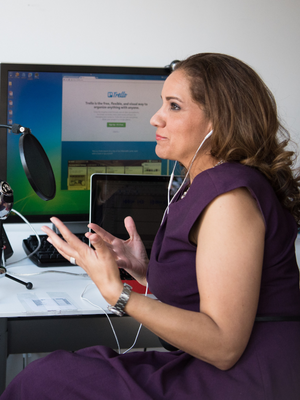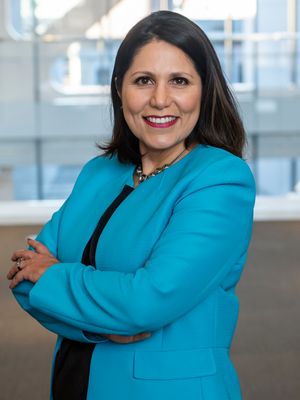 The gap in Latina leadership in Corporate America is still an inclusion issue. But as more Latinas decide to go where they are valued, it’s Corporate America that is losing out the most – and more so in the future.
The gap in Latina leadership in Corporate America is still an inclusion issue. But as more Latinas decide to go where they are valued, it’s Corporate America that is losing out the most – and more so in the future.
Hispanic and Latina women comprise only 1.6% of senior executives in the U.S.’s largest companies, less than other major demographic groups. USA TODAY reviewed 92 companies in the S&P 100 and found 18 had no Latinas in senior executive positions: including Apple, CostCo and Netflix. While few had a proportion equal to representation in the U.S. Workforce, PepsiCo, Procter & Gamble and Visa came closest.
It’s not just senior management: Latinas are underrepresented as only 4.4% of managers and 3.2% of professionals. And, according to the Latino Corporate Directors Association, Latinas hold only 1% of board seats in Fortune 500 companies, fewer than other gender or ethnic groups. But Latinas comprise 16% of the female labor force – the largest group behind white women, and by 2029, are projected to be 9.3% of the total US labor force.
Hispanic women earned 16.4% of bachelor’s degrees and 12.3% of master’s degrees in 2020, and Latinas represent 56% of Latinx students, though Latinx enrollment has taken some hit since the pandemic. Over two million Latina-owned small businesses exist – the fastest growing segment of the business community – with over 87% growth in business numbers since 2007. Latinas are creating business six times faster than any other group.
Barriers to Inclusion
Comprising 19% of the population and growing, Hispanic buying power continues to accelerate and demand that organizations understand this market.
While Latina women should have good reason to feel more emboldened than ever to bring their full identities to work through culturally relevant Latina leadership, they continue to be under-supported to do so and underpaid by corporate America.
When it comes to the paycheck, Latinas earn 55 cents for every dollar earned by non-Latino white men: even in the exact same job. Latinas earn 28% less than white women. The pay gap is also widest for Latinas with college degrees.
While Latinas ask for promotions and raises at similar rates to white men, the “broken rung” is exposed when you consider that Latinas are only 71% as likely as men in general to be promoted. Only 19% of Latinas feel supported by white co-workers. Only 5% of Latinos overall in big companies say they have a sponsor, whereas Latinos who do have sponsors are 42% more likely to be satisfied with career progression. Latinas who have reached executive levels often report the importance of that sponsorship in reaching where they are.
Latinas have reported being cast as caretakers, or the media image of ‘jefa of the household,’ rather than corporate leaders. Latinas are arguably more culturally wired for community building, a deeply held value which they often practice at home and that would serve organizations, but the value of individualism still dominates vertical mobility.
Latina women also report, according to Esther Aguilera, CEO of the Latino Corporate Directors Association, having to overcome biases around accents and myths and misperceptions around capabilities – which leads to a cycle, as we’ve heard echoed at The Glass Hammer this month, of Latina execs still feeling the internal drive of needing to prove themselves.
Indeed, 63% of Hispanic leaders indicated they have to work harder because of their ethnicity. And two in three Hispanic professionals felt educating coworkers around DEI falls upon them, spending substantial time whether it relates to their job or expertise.
Compared to non-Hispanic peers, Hispanic professionals are 53% less likely to feel included at work and 53% less likely to say they’re comfortable fully expressing their identities at work. Latina women have reported having to “check their identity at the door” or adjust their persona (code-switch) to fit into white masculine stereotypes of leadership.
The Post-Pandemic Impact
So it may come as no surprise that UCLA found that Latinas are leaving the workforce at higher rates than any other major demographic. Between March 2020 and March 2021, the workforce lost 336,000 Latinas, a drop of 2.74% in the workforce. Perhaps the promise of the American dream became too far stretched in reality for some, taking too much emotional, mental and physical toll without enough reward. One qualitative study found that senior level Latina talent were exiting Corporate America because of poor culture fit and a lack of evidence that Latinas were being structurally promoted.
“The Latina Pathway to Excellence in a Post-Pandemic World” report shared how the pandemic had changed the employment outlook of many Latinas. They both felt more invisible and yet found a “new virtual world confidence” in which they’ve learned to promote their profile more authentically at a professional level.
Mid-career Latinas expressed challenges such as: difficulty in maintaining their true selves in the workplace, a lack of champions they could identify with and trust, a lack of management check-ins, and lack of access to upper management. They emphasized the value of knowing your unique gifts and individual brand and leveraging the value that intersectionality brings to the table.
Executive-level leaders discussed promoting your distinct qualities, developing more skills and taking risks to seize opportunities amidst reduced visibility. They emphasized the importance of overcoming imposter syndrome as well as cultural Latin gender norms, being ‘ready to represent’ at the upper echelons amidst disproportionate scrutiny, and seeking mentorship and sponsorship (many had been sponsored by Latino men). They also encouraged trusting in the “Latina 6th sense” of intuition and decision making. Some C-Suite Latinas had leveraged the virtual meeting place to create new connections and visibility with senior leaders.
As written in Be Latina, “The growth of the virtual world allowed, in certain ways, for ‘authenticity in the business world.’”
It’s about Latina Inclusion
So what about organizations that want to get serious about promoting Latina talent? The answer is valuing the culture add and fostering cultural inclusion. At base level, greater inclusion for Hispanic and Latina women requires at least three things:
- Address unconscious bias in talent management decisions – Too many talent decisions are riddled in bias at each level (hiring, promotion, pay) and inhibiting organizations from leveraging and promoting Latina talent. From entry level recruitment to promotion to senior posts to pay packages, it’s possible to identify and shake up the way approaches have kept Latina talent from top positions.
- Make sponsorship happen – Ideally through formal sponsorship programs, managers and senior leaders should be challenged to reach beyond their own affinity bias and the gap in sponsorship for Latina women must close to transcend the block to corporate leadership.
- Encourage authenticity – Build a culture that celebrates each individual’s perspective, and the intersectionality that often informs that perspective, rather than pressures Latina women to forgo their wholeness to belong in the corporate workplace.
Please Don’t Check Your Identity!
Ask Hispanic and Latina executives, and showing up authentically can be the biggest challenge, but ultimately, there’s no path to stronger performance and personal fulfillment than being able to be who you are.
Latina women are bicultural, bilingual and possess many aspects of cultural wealth that can be leveraged as a leader. In part because of what it’s taken to get this far, Latinas often have developed strong skillsets of resilience, creativity, optimism, social ease, charisma, passion, relationship-building, multi-tasking and adaptability.
It’s recommended that Latinas who wish to thrive look for strong cultural fits that will value your whole selves, be persistent and also know when to adapt and take risks to overcome barriers. It’s important to accept imperfection in selves and others and be grounded in your ethnic background while navigating two cultures. Surround yourselves with mentors and those who can support your advancement.
One hunch about Latina leadership: it’s happening and those who embrace cultural diversity and inclusion will know the advantage of leveraging it.
By Aimee Hansen





